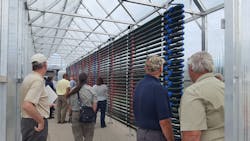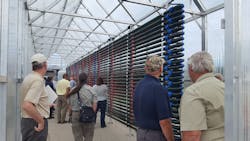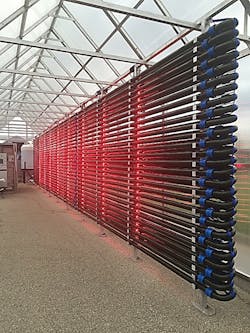Wis. wastewater treatment plant employs advanced biological nutrient recovery from Clearas
FOND DU LAC, WI, OCTOBER 5, 2016 -- The recent pilot program of Clearas Water Recovery’s Advanced Biological Nutrient Recovery (ABNRTM) treatment system conducted in partnership with the Fond du Lac Regional Wastewater Treatment Facility and manufacturing representatives, Mulcahy Shaw Water, has produced impressive results in the reduction of total phosphorus and other primary nutrients in the facility’s surface water discharge. To date, total phosphorus levels in the effluent used for piloting at Fond du Lac have averaged 0.032 mg/L with a resulting reduction of 94% post-treatment thanks to Clearas’ technology. Given the new, stricter regulatory requirements from the Wisconsin Department of Natural Resources for point source dischargers regarding phosphorus levels, plant superintendent, Jeremy Cramer, has been pleased with the performance of the Clearas ABNR system. “Our future total phosphorus limit will likely be 0.04 mg/L and the Clearas pilot unit is consistently treating our wastewater to levels below 0.04 mg/L”, said Cramer. While the Fond du Lac staff have been greatly pleased with the pilot results, they have been equally pleased with the easy adoption of the ABNR technology. According to Cramer, “The staff at Fond du Lac, especially the operations staff, has been able to easily understand the Clearas process due its operational parameters being closely related to that of the activated sludge process that we implement here.”
The Clearas pilot was set against a background of pressing nutrient issues in waterways throughout the region. A dominant challenge to the water quality of the state of Wisconsin are excessive nutrients, primarily nitrogen and phosphorus, which can result in Hazardous Algal Blooms (HABs). These HABs have a negative environmental and economic impact on the livelihood of those who rely on the many lakes within the state. Efforts to reduce excessive nutrients have typically been focused primarily on education and best management practices which have not by themselves been successful. There is a growing recognition that a comprehensive solution, involving education, best management practices and technology is required to address this.
To showcase the results of Clearas’ ABNR technology, representatives from the partnership recently held tours of the facility and presentations for over 140 wastewater operators, regulators, and engineers from across the Great Lakes region.
Those attending had the opportunity to meet various principals from the partnership, including Clearas Vice President, Garrett Pallo, and co-founder, Terry Robinson, who were excited about the level of interest shown in the technology. "I think our nutrient recovery results speak for themselves," said Pallo adding, "any time we can connect with folks on the ground working to meet the highest water quality standards in the nation, it gives us a chance to shine."
Mr. Robinson recently spent a significant amount of time traveling around Wisconsin with Mulcahy Shaw partners, Tom Mulcahy and Rich Knoelke to meet with various stakeholders. With multiple meetings and additional discussions currently underway, Robinson said, "We’re confident that Clearas’ best-in-class ABNR technology provides Fond du Lac and every other facility in the region the sustainable, affordable solution that they’ve been looking for to comply with these new regulations."
The Clearas Advanced Biological Nutrient Recovery (ABNR™) solution is a natural and sustainable technology which relies on microbiology (algae) that is already present in wastewater processes to consume nutrients that are dissolved in the waste stream and ultimately filtered out. Much like trees and plants, this microbiological process consumes nutrients (Nitrogen, Phosphorus and CO2) and releases oxygen into the water.
Nutrients present in wastewater are generally classified as either suspended or dissolved. Suspended nutrients are particulate in the water that can be removed fairly easily using numerous filter solutions. The dissolved portion is in solution and therefore presents challenges in removal / recovery. The ABNR technology addresses the dissolved nutrient portion by creating an optimized environment for the algae to consume the nutrients after which it can be removed / recovered.
ABOUT CLEARAS WATER RECOVERY
Clearas is the leading provider of advanced, biological-based, water treatment technologies for municipal and industrial point source dischargers. Our proprietary technology leverages algae’s biological benefits in a carefully controlled and continuous flow environment that removes nitrogen, phosphorus and other harmful nutrients found in industrial water discharge and wastewater effluent. Visit www.clearaswater.com for more information.
ABOUT MULCAHY SHAW WATER
Mulcahy Corporation was founded by John T. Mulcahy in 1974. John represented a sampling & flow monitoring company, ISCO, out of Lincoln, Nebraska. John ran the company until 1992 when Tom Mulcahy became the Owner & President. Under Tom’s direction, Mulcahy Corporation has added personnel & manufacturing partners that have allowed the company to better meet the needs of the industry. Mulcahy Shaw Water has been serving clients, principals & distributors since 1974. We are driven to exceed expectations & build long-lasting relationships throughout our territory. Visit www.mulcahyshaw.com for more information.
ABOUT CITY OF FOND DU LAC WASTEWATER TREATMENT
The Fond du Lac Regional Wastewater Treatment Facility is located on Doty Street, on the south end of Lake Winnebago. This plant treats all of Fond du Lac's wastewater along with that of neighboring communities, approximately 65,000 residents, to prepare the water for discharge into Lake Winnebago. Visit www.fdl.wi.gov for more information.


